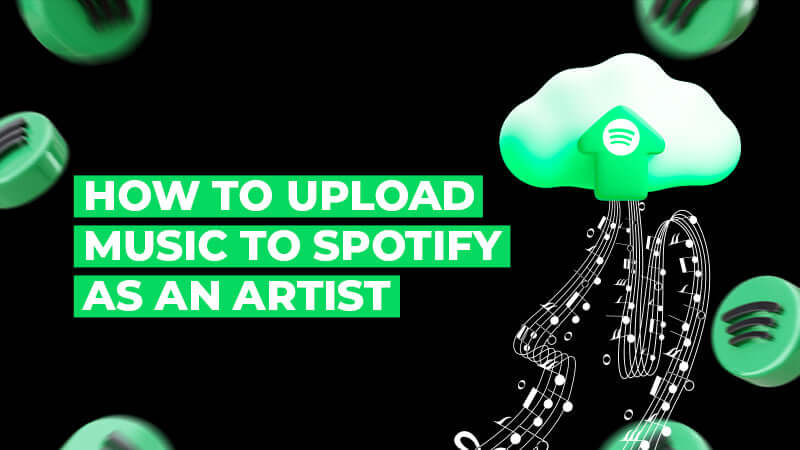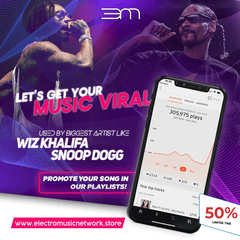
How To Upload Music To Spotify As An Artist
For musicians trying to connect with fans and earn a living, Spotify has been a great resource. Musicians have a wide range of alternatives thanks to features like Spotify for Artists that can help them build a fan base and gain insightful knowledge of the relevant information. A wonderful approach for a new musician to get exposure is through Spotify, which has more than 420 million active users each month.
And keep in mind how important Spotify statistics are to the music industry. A record label, management, or booking agency may notice you if you are successful on Spotify. They will almost probably ask you how your music is doing on Spotify no matter how you introduce yourself. Thus, if you have ambitious aspirations for your artistic career, this is the ideal starting point..

Photo by Daniel Chekalov on Unsplash
Can An Independent Artist Upload Music To Spotify?
If you've been considering making your music available on streaming services, the only thing stopping you is your inability to do so on your own. You must speak with a digital music distributor because Spotify doesn't collaborate with independent artists and labels directly. Digital distributors continue to serve the crucial role of having your music heard because streaming services account for the majority of new music consumption. But, they are now also in charge of including it in streaming platforms like Spotify.
How to Choose a Distributor to Upload to Spotify
It's essential to select the distributor who can best meet your needs. The best part is that a music distributor will concurrently upload your music to a number of platforms, including Spotify as well as iTunes, Apple Music, Amazon Music, Tidal, Pandora, Google Play Music, and others. By sharing your music throughout several streaming sites, you could enhance the overall number of streams for your music.
A wide variety of distribution options are offered, each with a particular price point and extra features. You might recognize some of these. DistroKid, CD Baby, TuneCore, Ditto Music, AWAL, and others are just a handful. And sure, working with a distributor usually entails paying a charge. But don't worry; as soon as your music is made available on streaming platforms, it will begin to draw attention and you will begin to receive royalties from these streams. Of course, some distributors only take a cut of your royalties instead of the fee. Yet, it's preferable to keep all of your music to yourself rather than refuse to pay for the services you receive.
What Is Required From Artists Before Track Submission?
Before submitting their work to a digital music distributor, independent musicians should take into account Spotify's special rules and technical specifications. You will be ready to start the music uploading process once you have selected your preferred distribution and finished the registration process. Depending on the distribution, the file format for digital music may need to adhere to different requirements.
You should submit the greatest available lossless file(s) of your music, as obvious as that may sound. Spotify Premium has more listeners than its competitors because it streams at 320kbps, which is a greater quality than what you get on other platforms. It would be beneficial if you initially remembered that your music needs to be professionally mixed and mastered. Provide audio files that are optimized for streaming rather than CD, vinyl, or another format. Avoid MP3 and only upload high-resolution (16-bit, 44.1 kHz) WAV audio files.
It would be beneficial if you also remembered:
- You may only upload music for which you own the master recording rights.
- You need the owners' permission to use their samples in music.
- Copyrighted tracks shouldn't often be released without the owners' permission.
- Spotify should not host content that is illegal, offensive, or obscene.
What about covers and remixes on Spotify?
If the original music is not your own and you want to remix it, you must have the owners of the original audio recording (often the record company that made the track) as well as the authors, composers, and publishers' permission. If you've integrated all or a portion of the original recording into your music, it counts as a remix.
You may disseminate your release if the songwriters of the song you want to cover are not citizens of the United States, but they always have the right to request that your cover song be taken down. On the other side, a collecting society will need to issue a mandatory license. Only if your song's words, melody, and basic arrangement are identical to those of the original, except from the fact that you are a performer, would it be considered a cover version. As soon as the lyrics, melody, or basic arrangement are changed, a song is not considered a cover.

Photo by Brett Jordan on Unsplash
What About The Album Cover?
Album cover art and music video trailers are additional important considerations. Spotify has strict requirements for cover art. Make sure the artwork is at least 640 x 640 pixels in size and in the TIFF, PNG, or JPG format. However, other distributions might have additional specifications beyond what Spotify asks, such as higher pixel counts and related things. For instance, some distributors will not accept artwork that contains names, logos, or language or imagery that is unsuitable. Others permit the names of the artists or the work's titles to be shown.
To avoid any delays in the transmission of your music, you must make sure that your artwork conforms with all the requirements of your desired distribution method. However, you should also carefully read the rules outlined by your distribution regarding what is and isn't allowed. Another option is to create a video cover for a song using Spotify's Canvas.
What Information Do You Need To Provide Regarding Your Music?
Let's say you're adding a single song to Spotify. The title of your song or instrumental piece will then just be this. You'll have an EP or album after adding a few more tracks; you'll need to fill out the fields for each track and give the album a name. Be mindful that different record labels have varied definitions of what constitutes a single, EP, or album. This, however, has no impact on how files are uploaded.
Your chosen distributor will ask if the music is an original composition, a remix, a cover song, an instrumental, or a live performance. If the recording year is different from the release year, they might also be curious. Also, you must say whether your music has explicit lyrics. You must select the genre or style of your music from a list provided by the distributor. If the track(s) have already been released, you must submit an ISRC (International Standard Recording Code) to identify your track and link royalties.
When pressing the final "submit" button on DistroKid, TuneCore, CD Baby (or your preferred distributor), make sure all the required fields are filled out completely. Then, verify everything once more.
How Long Do Artists Need To Wait For The Release?
Your music will go at a different pace from the distributor to the streaming provider. As a result, if you want to release your music on a specified day, you must upload it far in advance. For the majority of distribution channels, you can also select a specific release date to allow yourself more time to promote and approach Spotify playlists with your song.
How Do You Earn Money From Spotify?
When a song is played on a streaming site, the artist essentially receives royalties (depending on the number of streams). How much Spotify actually pays each stream is a complicated issue with a complicated answer. It varies based on a lot of factors, but the price per stream is estimated to be between $0.008 and $0.90.
Streaming rewards can take a variety of shapes:
- Mechanical royalties are payments made to songwriters and their publishers in exchange for the right to reproduce the music.
- Public performance royalties are payments made to songwriters and their publishers in exchange for the right to perform their music in public. Because the listener doesn't actually own any of the music, every stream even one that is merely being listened to on a phone is seen as a public performance.

Photo by @felipepelaquim on Unsplash
What To Do After The Upload?
If you believe that after your song or album is finally available on Spotify, your effort is finished, you are mistaken. There are a lot of other things you can do to get listeners to visit your Spotify profile, like engage with followers on social media or create an artist playlist, but you can't achieve it without the following action. You should request your artist profile through Spotify for Artists as soon as the release is available on the platform. Only following the initial release of the official track will you be able to do this. If you want to claim your Spotify for Artists page, be prepared for the procedure to take some time since Spotify needs to first confirm your identification.
But, opening a Spotify account directly through a distributor or the distributor for your label only takes a few seconds. Spotify does not need to go through its lengthy verification process because CD Baby and Distrokid and other distributors can do so immediately.
The next step is to make a solid music promotion plan and get your songs on Spotify playlists after you've addressed this important issue.
Spotify Playlists Are Here To Help
Prioritizing having their songs on popular Spotify playlists is important for any musician that releases music. These playlists come in three varieties: Spotify-curated playlists, playlists by independent artists, and playlists from well-known record labels. It's not too difficult to pitch your music to the first two. Unfortunately, it's nearly impossible to find the ones from the larger labels.
You can submit your music for the official Spotify playlist through your Spotify for Artists page. Before sending it to the playlist editors, upload your song to Spotify three to six weeks before its planned release. When the track is uploaded, visit your Spotify Artist profile to view it.
Then, click the "Upcoming" option at the top of the page. A thorough form will appear that you must fill out in order to promote your track to the curators. All that's left to do is wait after that.
Unofficial playlists made by common users and other community members are another fantastic resource offered by Spotify. Although technically unauthorized, many of these playlists have tens of thousands of subscribers. When it has been publicly launched, sending your track to these curators and tastemakers can significantly enhance the amount of plays. This kind of service is available on our website, where you can pitch your music straight to our playlists.
This is something we can help you with. A platform for music promotion called EM Network - Once your music in our playlists, you will notice an overnight change. Your music will reach new people everyday and continue to do so for 10-30 days. There is nothing more satisfying than seeing the results of a successful campaign convert into engagement and social traction from new fans. The best part of it all? You're now getting paid for your music.
The procedure is straightforward: simply go to the EM Network Spotify Playlists Placements product , add your spotify song link , grab the package that fit's your budget and needs and launch your campaign! We encourage you to create a bright artistic future!


